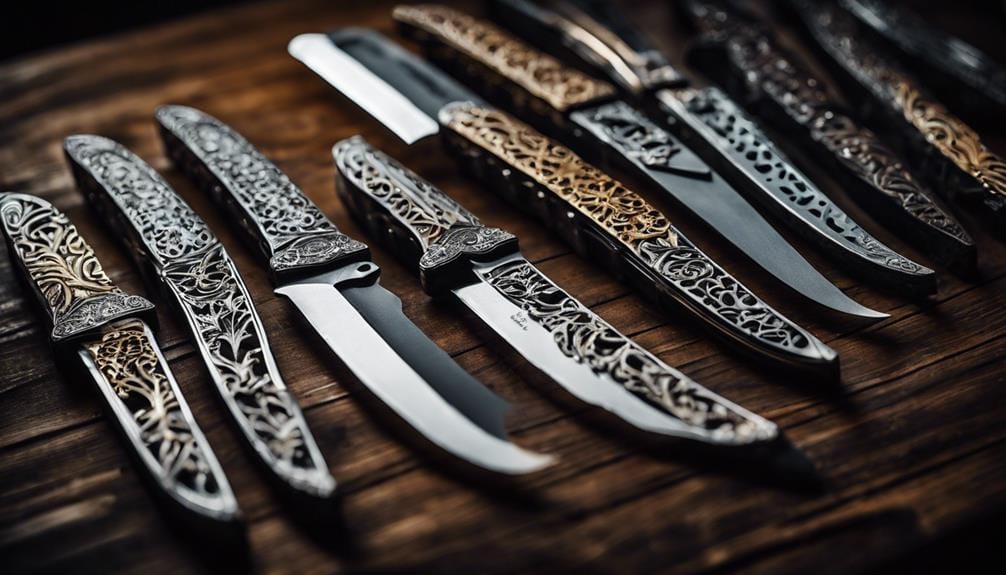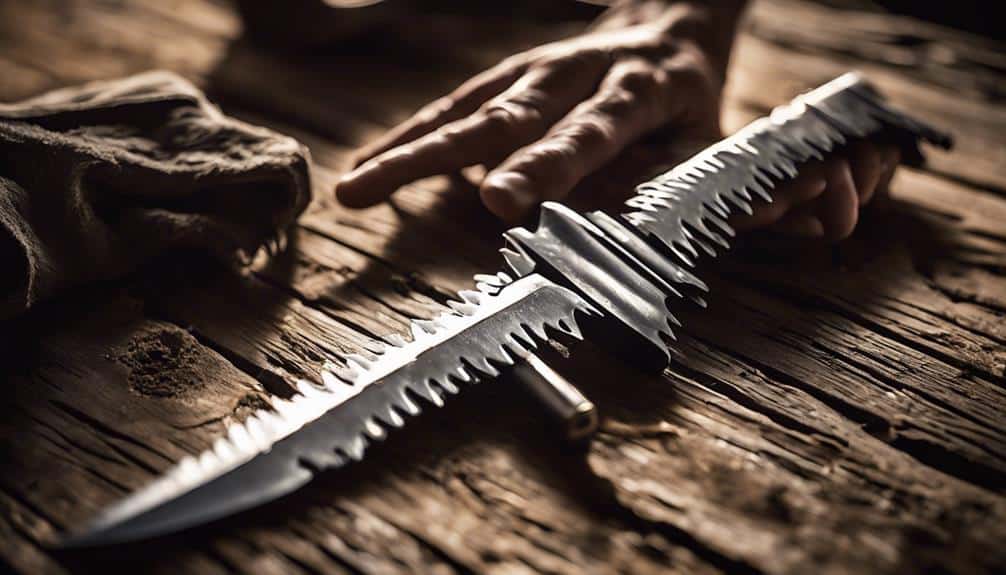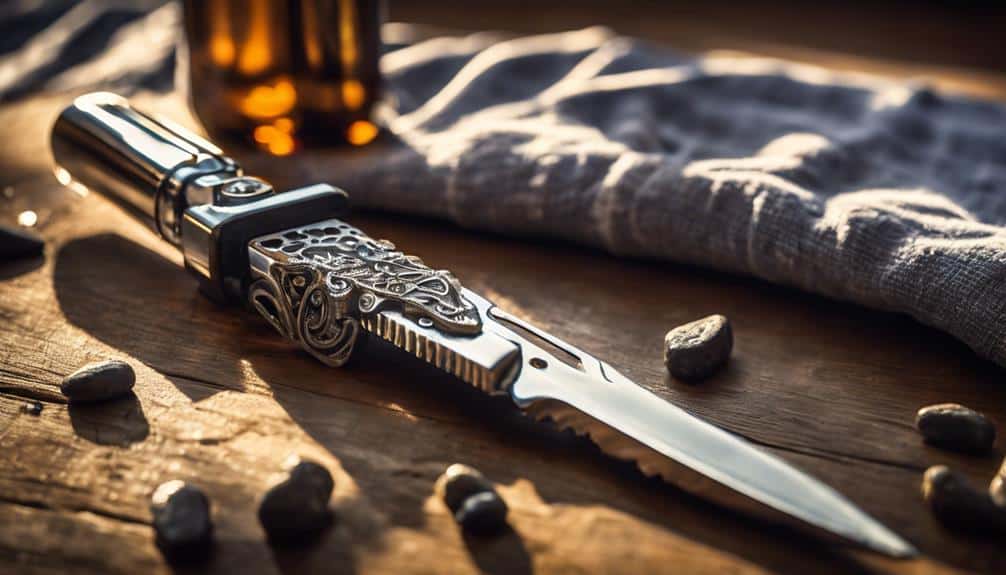A Dance of Steel: Mastering the Art of the Butterfly Trench Knife
You might think mastering the butterfly trench knife is just about skill with a blade, but it’s much more. This weapon, rooted in Filipino history, demands a blend of precision, artistry, and respect for its cultural heritage. As you learn the basic flipping techniques, you’ll uncover a world where every flip and twirl tell a story. But before you immerse yourself in the advanced moves, understanding the knife’s anatomy and the legal considerations is essential. What hidden lessons does this dance of steel hold for those willing to explore its depths?
 Butterfly knives, also known as balisongs, originated in the Philippines and were initially crafted for self-defense, enabling users to wield them with one hand while keeping the other free for protection. These versatile tools found their roots among Filipino farmers and fishermen in the early 1900s, where they served not only as weapons but also as practical utility knives. Imagine tending to your crops or mending fishing nets one moment and flipping your butterfly knife to fend off a threat the next – that’s the kind of adaptability these knives offered.
Fast forward to World War I, and you’ll find the Butterfly Trench Knife making its debut in close-combat warfare. Soldiers relied on its quick deployment and compact design during intense, up-close encounters. The well-balanced and lightweight handle design made it an ideal choice for these situations. As butterfly knives spread to Southeast Asia, Europe, and the United States, their style and function evolved, yet their iconic flipping mechanism remained unmistakable.
However, be mindful that legal restrictions on butterfly knives vary widely across U.S. states. Some places celebrate the balisong’s storied history, while others impose strict regulations or outright bans. So, always check your local laws before adding one to your collection
Butterfly knives, also known as balisongs, originated in the Philippines and were initially crafted for self-defense, enabling users to wield them with one hand while keeping the other free for protection. These versatile tools found their roots among Filipino farmers and fishermen in the early 1900s, where they served not only as weapons but also as practical utility knives. Imagine tending to your crops or mending fishing nets one moment and flipping your butterfly knife to fend off a threat the next – that’s the kind of adaptability these knives offered.
Fast forward to World War I, and you’ll find the Butterfly Trench Knife making its debut in close-combat warfare. Soldiers relied on its quick deployment and compact design during intense, up-close encounters. The well-balanced and lightweight handle design made it an ideal choice for these situations. As butterfly knives spread to Southeast Asia, Europe, and the United States, their style and function evolved, yet their iconic flipping mechanism remained unmistakable.
However, be mindful that legal restrictions on butterfly knives vary widely across U.S. states. Some places celebrate the balisong’s storied history, while others impose strict regulations or outright bans. So, always check your local laws before adding one to your collection
 When delving into the world of butterfly knives, you’ll encounter two primary types: channel construction and sandwich construction. Channel construction butterfly knives are crafted from a single piece of metal, forming the handle’s backbone. This design offers increased durability and a balanced weight distribution, making them a favorite among seasoned enthusiasts. On the other hand, sandwich construction knives consist of multiple layers of metal pinned together, allowing for easier maintenance and customization. The Butterfly Knife Black is an excellent example of a well-balanced design perfect for flipping.
You might also come across specialized variants like the Butterfly Trench Knife, designed for close-combat situations. Its robust build and tactical edge make it a formidable tool. For those just starting out or looking to practice safely, a butterfly knife trainer is your best friend. These trainers feature unsharpened blades, so you can master your flips and tricks without the risk of injury.
Butterfly knives typically boast blade lengths ranging from 3 to 5 inches, made from materials like stainless steel or high-carbon steel. Whether you’re collecting for self-defense or as a hobby, there’s a wide range of options available, with prices starting as low as $9.99. So, grab a butterfly knife trainer and start honing your skills today
When delving into the world of butterfly knives, you’ll encounter two primary types: channel construction and sandwich construction. Channel construction butterfly knives are crafted from a single piece of metal, forming the handle’s backbone. This design offers increased durability and a balanced weight distribution, making them a favorite among seasoned enthusiasts. On the other hand, sandwich construction knives consist of multiple layers of metal pinned together, allowing for easier maintenance and customization. The Butterfly Knife Black is an excellent example of a well-balanced design perfect for flipping.
You might also come across specialized variants like the Butterfly Trench Knife, designed for close-combat situations. Its robust build and tactical edge make it a formidable tool. For those just starting out or looking to practice safely, a butterfly knife trainer is your best friend. These trainers feature unsharpened blades, so you can master your flips and tricks without the risk of injury.
Butterfly knives typically boast blade lengths ranging from 3 to 5 inches, made from materials like stainless steel or high-carbon steel. Whether you’re collecting for self-defense or as a hobby, there’s a wide range of options available, with prices starting as low as $9.99. So, grab a butterfly knife trainer and start honing your skills today
 To get started with basic flipping techniques, first grab the handles of your butterfly trench knife using the Filipino Grip, making sure your hold is firm yet relaxed for ideal control. Begin with the basic open technique by flicking your wrist to smoothly propel the blade from the handles, aiming for fluid movements that reveal the blade effortlessly. When closing the knife, simply reverse this motion, practicing until you can safely conceal the blade back within the handles with the same ease; remember, consistency is key and a trainer knife like the WAYDA Butterfly Knife is your best friend to avoid any unfortunate accidents while you get the hang of it.
To get started with basic flipping techniques, first grab the handles of your butterfly trench knife using the Filipino Grip, making sure your hold is firm yet relaxed for ideal control. Begin with the basic open technique by flicking your wrist to smoothly propel the blade from the handles, aiming for fluid movements that reveal the blade effortlessly. When closing the knife, simply reverse this motion, practicing until you can safely conceal the blade back within the handles with the same ease; remember, consistency is key and a trainer knife like the WAYDA Butterfly Knife is your best friend to avoid any unfortunate accidents while you get the hang of it.
The aerial technique requires flipping your knife into mid-air and catching it, a feat demanding impeccable wrist control and timing. As you progress, the twirl technique will have you spinning the knife around your fingers or wrist, adding a mesmerizing fluidity to your movements.
Then there’s the helicopter, where you spin the knife in a circular motion. It might feel like juggling chainsaws at first, but with consistent practice, you’ll achieve a smooth execution. Finally, the contact flip, which involves manipulating the knife with just your fingertips, will test your balance and control to the max.
 To keep your butterfly trench knife in top shape, start by regularly cleaning the blade and handles with a soft cloth to nix any dirt and moisture, preventing rust—think of it as giving your knife a mini spa day. The metal knuckle guard should also be cleaned and checked for any signs of wear. Periodic oiling of the pivot points and latch mechanisms guarantees smooth flipping action and longevity, much like how a little oil keeps your bike chain from squeaking. Finally, tighten those screws and check for any loose components to assure peak functionality and safety, because nobody wants a surprise mid-flip.
To keep your butterfly trench knife in top shape, start by regularly cleaning the blade and handles with a soft cloth to nix any dirt and moisture, preventing rust—think of it as giving your knife a mini spa day. The metal knuckle guard should also be cleaned and checked for any signs of wear. Periodic oiling of the pivot points and latch mechanisms guarantees smooth flipping action and longevity, much like how a little oil keeps your bike chain from squeaking. Finally, tighten those screws and check for any loose components to assure peak functionality and safety, because nobody wants a surprise mid-flip.
 Celebrated for their mastery and agility, famous users of the Butterfly Trench Knife have left an indelible mark on both martial arts and popular culture. Bruce Lee, the martial arts legend, wielded these knives with unparalleled finesse in his films, enchanting audiences and inspiring countless enthusiasts to explore their potential. His fluid movements and precise techniques showcased the Butterfly Trench Knife as more than just a weapon—it became an extension of his artistry.
Ernest Hemingway, renowned author and adventurer, was another notable figure who carried a butterfly knife. He appreciated its combination of practicality and style, making it a fitting companion for his adventurous lifestyle. Imagine Hemingway, penning a novel with a butterfly knife at his side, ready for any challenge that might arise—quite the image, right?
Even in modern times, survival expert Bear Grylls has been seen using butterfly knives in various survival scenarios, demonstrating their utility in the wild. Grylls’ endorsement underscores their practicality for outdoor enthusiasts.
Here are three key takeaways about these famous users:
Celebrated for their mastery and agility, famous users of the Butterfly Trench Knife have left an indelible mark on both martial arts and popular culture. Bruce Lee, the martial arts legend, wielded these knives with unparalleled finesse in his films, enchanting audiences and inspiring countless enthusiasts to explore their potential. His fluid movements and precise techniques showcased the Butterfly Trench Knife as more than just a weapon—it became an extension of his artistry.
Ernest Hemingway, renowned author and adventurer, was another notable figure who carried a butterfly knife. He appreciated its combination of practicality and style, making it a fitting companion for his adventurous lifestyle. Imagine Hemingway, penning a novel with a butterfly knife at his side, ready for any challenge that might arise—quite the image, right?
Even in modern times, survival expert Bear Grylls has been seen using butterfly knives in various survival scenarios, demonstrating their utility in the wild. Grylls’ endorsement underscores their practicality for outdoor enthusiasts.
Here are three key takeaways about these famous users:
History of Butterfly Knives

Anatomy of a Butterfly Knife
Understanding the anatomy of a butterfly knife is essential for anyone looking to master its use. A butterfly knife consists of two handles that pivot around a central tang, allowing you to swiftly conceal or expose the blade with a flick of your wrist. This unique design not only makes it a fascinating tool but also a practical one. The Butterfly Trench Knife boasts a heavy-duty metal construction and a 5.5-inch serrated blade, ensuring both durability and sharpness. Here’s a quick breakdown of its main components:- Blade: Typically, 3 to 5 inches long, the blade is crafted from high-quality materials like stainless or high-carbon steel, ensuring durability and sharpness.
- Handles: Made from materials such as aluminum, titanium, or wood, the handles provide comfort and a secure grip. They come in two main construction types: channel and sandwich. Channel construction uses a solid piece, while sandwich construction consists of two separate pieces.
- Latch: This mechanism secures the handles when the knife is closed, enhancing safety and ease of use for practitioners.
Types of Butterfly Knives

Legal Considerations
Before you start mastering your butterfly trench knife skills, you’ve got to navigate the legal maze surrounding these knives. Local knife laws can be a real puzzle, varying wildly from one state to another, so make sure to check if your state treats them like switchblades or allows them only for specific uses like self-defense or martial arts. Don’t get caught off guard—ensure you’re up to date on transport and carry rules to avoid any unwanted fines or legal drama!Local Knife Laws
Maneuvering the maze of local knife laws is vital if you’re considering buying a Butterfly Trench Knife. These unique butterfly knives can be subject to various legal restrictions, so it’s important to do your homework. Many states classify butterfly knives as switchblades or automatic knives, which can greatly affect their legality and ownership. Keeping in mind the safety benefits of proper knife usage can also help you understand why these regulations exist. To help you navigate these laws, consider this important checklist:- State-Specific Regulations: Some states, like California and New York, have stringent regulations that outright ban the possession or public carry of butterfly knives. Always check your state’s laws first.
- Blade Length Restrictions: Many jurisdictions limit blade lengths to a maximum of 3 inches for legal carry. Measuring your knife’s blade can help you stay compliant.
- Legal Consequences: Violating local knife laws can lead to fines or having your knife confiscated. It’s not worth the risk, so always verify you’re in the clear.
Transport and Carry Rules
Understanding the transport and carry rules for butterfly trench knives is essential if you want to stay on the right side of the law. The legality of carrying a butterfly knife can be a legal labyrinth, varying wildly by state and even by city. Some jurisdictions outright ban these knives, while others impose strict regulations on how they’re carried, often requiring them to be in a closed position. In places where butterfly knives are classified as “switchblades” or “automatic knives,” you’ll face even stricter rules, similar to those governing other self-defense tools. For example, in California, carrying a butterfly knife with a blade longer than two inches can be a criminal offense. And don’t even think about bringing one to New York City, where they’re pretty much forbidden. To avoid fines, criminal charges, or having your prized knife confiscated, you must research and understand your local laws. Imagine explaining to a judge that you missed the fine print—yikes! Always check if specific regulations dictate how and where you can transport your butterfly trench knife. Staying informed is your best weapon against legal trouble, ensuring you can enjoy your knife responsibly and legally.Proper Usage Guidelines
Maneuvering the proper usage guidelines for butterfly trench knives involves more than just knowing how to handle the blade. You need to navigate a labyrinth of legal considerations to guarantee you’re on the right side of the law. For instance, states like New York and Hawaii ban them outright, similar to their stun gun restrictions. Here’s a quick rundown to keep you out of trouble:- Check Local Laws: Butterfly knives, including trench knives, have varying legality across states. Some places ban them outright, while others have restrictions. Always research your local laws before purchasing or carrying your butterfly blade.
- Understand Classifications: In some jurisdictions, butterfly knives are classified as “switchblades” or “automatic knives.” These classifications can affect the legality based on specific state definitions. Make sure you understand how your state defines these terms.
- Conceal and Use Wisely: To avoid unnecessary attention, keep your knife concealed and use it only in designated safe spaces. Public display can lead to misunderstandings and potential legal consequences.
Basic Flipping Techniques

Developing Solid Grip
Mastering the butterfly trench knife starts with developing a solid grip using the Filipino Grip, a technique that involves holding the safe handle firmly while keeping the bite handle away from your body. This grip is essential because it sets the foundation for your control and precision during flips and tricks. Without it, you might find yourself more fumble-fingered than a magician at a children’s party. Opting for a heavy-duty design can also enhance the stability and longevity of your practice tools. To get started, remember these tips:- Choose a Butterfly Trainer: Practice with a trainer knife, which has a dull blade to guarantee safety while you learn the ropes.
- Focus on Handle Placement: Grip the safe handle tightly, allowing the bite handle to swing freely. This prevents accidental injuries.
- Build Muscle Memory: Consistency is key. Daily practice helps solidify your grip, making it second nature.
Basic Open Techniques
The key to nailing basic open techniques lies in understanding the mechanics of each flip. Start by establishing a solid grip using the Filipino Grip; it’s vital for gaining control and stability while flipping your butterfly knife. Picture yourself holding the knife confidently; this grip sets the stage for all your moves. Next, practice the basic open technique with a flick of the wrist. Imagine propelling the blade from the handles like a magician revealing a card trick—smooth and fluid. Rotate one handle away from the blade while moving the opposite handle towards it. This simultaneous motion is like a dance, coordinating both hands in perfect harmony. Consistency is your best friend here. Dedicate time daily to practice these fundamental open and close techniques. This repetition builds muscle memory, essential for mastering advanced moves. Think of it like learning to play an instrument; the more you practice, the more naturally it comes. And always, always use a trainer knife with a dull blade during practice. Trust me, your fingers will thank you. Developing your butterfly knife skills safely guarantees you can impress without distress. Happy flipping!Wrist Flick Dynamics
When you’re diving into wrist flick dynamics, think of your wrist as the engine driving the motion. The power and precision of your wrist flick are essential to flipping the butterfly trench knife open smoothly. Start by mastering the Filipino Grip, which provides the stability and control necessary for this technique. Your grip should be firm, yet flexible enough to allow for swift movements. To nail the wrist flick dynamics, follow these steps:- Angle the Blade: Position the blade slightly downward. This helps it open without resistance.
- Focus on Muscle Memory: Consistent practice refines your motion, making each flick more accurate.
- Use a Trainer Knife: Begin with a dull blade to minimize injury risk while getting comfortable with the flicking motion.
Advanced Flipping Techniques
While you may have already grasped basic flipping maneuvers, delving into advanced flipping techniques with a butterfly trench knife opens up a whole new domain of skill and finesse. To master these advanced moves, you’ll first want to practice with a trainer knife, ensuring safety as you hone your precision and control.Essential Flipping Techniques
| Technique | Key Elements |
|---|---|
| Aerial | Strong wrist control, precise timing |
| Twirl | Fluid motion, dexterity |
| Helicopter | Exceptional coordination, consistent practice |
| Contact Flip | Balance, fingertip manipulation |
Maintenance and Care

Cleaning and Lubrication
How essential is it to maintain your butterfly trench knife? Incredibly essential! Regular cleaning and lubrication are key to guaranteeing your knife remains in peak condition. After each use, grab a soft cloth and wipe down the blade and handles to remove any moisture and debris. This simple step helps prevent rust and corrosion, which can greatly shorten your knife’s lifespan. Just like the credit card foldable knife, proper maintenance will guarantee longevity and peak performance. When it comes to lubrication, focus on the pivot points. A lightweight oil, like machine oil or silicone spray, works wonders in keeping the knife’s action smooth and preventing wear. Avoid using harsh chemicals or abrasive materials; they can damage the knife’s finish or components. Here’s a quick rundown to keep your knife in top shape:- Clean: Wipe down with a soft cloth after each use.
- Lubricate: Apply lightweight oil to pivot points.
- Avoid Harsh Chemicals: Stick to gentle products.
Storage Best Practices
After ensuring your butterfly trench knife is clean and well-lubricated, proper storage becomes your next priority. To prevent rust and corrosion, store your knife in a dry, cool place. Moisture is the enemy of steel, and a damp environment can quickly degrade the blade’s integrity. Use a protective sheath or case whenever the knife isn’t in use. This not only shields the blade from accidental damage but also keeps the handles in top condition. A good sheath is like a snug little bed for your knife, ensuring it stays pristine and ready for action. Regularly tighten the screws and joints to maintain functionality. Even the best-made knives can suffer from looseness over time. Think of it like tuning a musical instrument; a little adjustment here and there keeps everything harmonious. Avoid exposing your knife to extreme temperatures or direct sunlight for extended periods. Imagine leaving your knife in a hot car—it’s not a good idea. Extreme heat can warp the materials and mess with the knife’s balance, making it less effective when you need it most. And don’t forget to clean the blade with a soft cloth after each use. This simple act removes any debris or moisture, ensuring your knife’s longevity and peak performance.Routine Inspection Tips
Regular inspection of your butterfly trench knife is vital for maintaining its performance and safety. To guarantee your knife stays in top condition, make routine checks part of your maintenance ritual. Here are some key routine inspection tips to keep your knife at its best:- Check for Wear and Damage: Inspect the blade and handle joints for any signs of wear, nicks, or damage. Even minor imperfections can affect the knife’s operation, making it less safe to use.
- Clean and Lubricate: Use a soft cloth to clean the blade and handles, removing any dirt and moisture. This prevents rust and corrosion, which can compromise the knife’s performance. Apply a few drops of lubricant to the pivot points and latch mechanism to guarantee smooth opening and closing actions.
- Tighten Screws: Periodically check and tighten all screws on the knife. Loose screws can impact the knife’s functionality and safety, potentially causing accidents during use.
Cultural Significance
The Butterfly Trench Knife‘s cultural significance is deeply rooted in its storied past and its impact on martial arts traditions. Developed during World War I, this knife quickly became an iconic symbol of close-combat warfare, celebrated for its agility and precision. Its design, known for unique flipping techniques, has profoundly influenced various martial arts forms, especially within the Filipino martial arts community. You might be surprised to learn that the Butterfly Trench Knife isn’t just a tool for combat—it’s an artistic expression. In the Philippines, it’s not uncommon to see martial artists performing intricate knife flipping routines that showcase both skill and tradition. These performances aren’t just for show; they reflect a deep cultural heritage, blending artistry with combat effectiveness. The knife’s appeal extends beyond martial arts schools; it’s also a star in popular media, inspiring countless martial arts demonstrations and performances worldwide. As you watch these dazzling displays, you’re witnessing more than just a weapon in action—you’re seeing a cultural artifact that tells a story of resilience and mastery. So, next time you see a Butterfly Trench Knife, remember, it’s not just steel; it’s a dance of history and heritage.Famous Users

- Bruce Lee: Martial arts icon who popularized the knife in films.
- Ernest Hemingway: Adventurer and author who appreciated its practicality.
- Bear Grylls: Survival expert who demonstrated its utility in the wild.
Common Misconceptions
Despite the widespread allure of butterfly knives, several misconceptions continue to cloud their reputation. One of the biggest myths is that butterfly knives are primarily weapons and are universally illegal. In reality, their legality varies by state and country, so it’s essential to research local laws before ownership or carry. Another common misconception is that all butterfly knives are sharp and dangerous. However, trainer knives like the WAYDA Butterfly Knife have unsharpened blades, making them perfect for safe practice and skill development. The belief that mastering butterfly knife tricks is easy is also misleading. It takes significant practice, coordination, and muscle memory to skillfully manipulate these knives. Many people also assume all butterfly knives are the same. In truth, there are distinct types, such as Trench and Trainer knives, each designed for different purposes and catering to various skill levels. Collectors and martial artists often appreciate butterfly knives for their mechanical intricacies and artistry, not just their potential use as weapons.| Misconception | Reality | Example |
|---|---|---|
| Universal illegality | Varies by state/country | Research local laws |
| Primarily sharp and dangerous | Trainer knives are safe for practice | WAYDA Butterfly Knife |
| Easy to master | Requires significant practice and coordination | Developing muscle memory |
| All the same | Different types for various purposes and skill levels | Trench vs. Trainer knives |
Frequently Asked Questions
What Is the Story of Butterfly Knife?
You’re exploring the story of the butterfly knife. It started in the Philippines for self-defense, then evolved into a symbol of cultural significance. Its unique design and flashy techniques captivated martial artists and enthusiasts worldwide.What Was the Purpose of the Butterfly Knife?
You’d find the butterfly knife, a marvel of combat utility, was designed for self-defense. Its swift deployment and discreet design made it an ideal companion in close encounters, ensuring you were always ready for a surprise.In What States Are Butterfly Knives Legal?
You need to know the legal variations regarding butterfly knives. They’re legal in states like Texas, Florida, and Pennsylvania. However, states such as California, New York, and Illinois impose restrictions or bans. Always check local regulations.Why Are Butterfly Knives Illegal in Canada?
In Canada, butterfly knives are illegal due to their design, which allows rapid deployment and concealment. Their cultural significance ties to criminal activity and potential misuse, raising public safety concerns and leading to their prohibition.
Facebook
Twitter
LinkedIn
Pinterest

